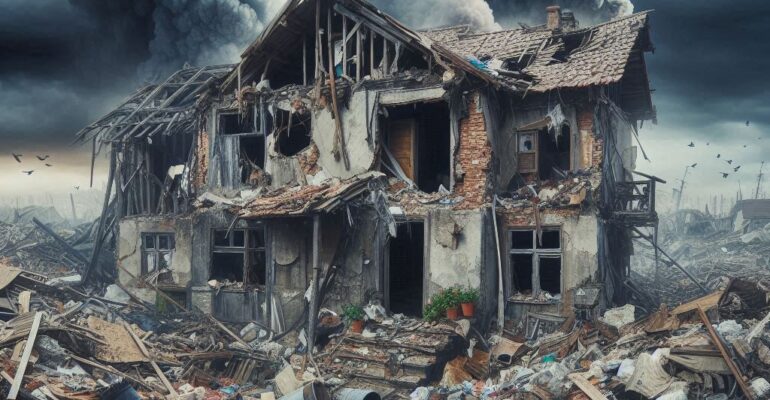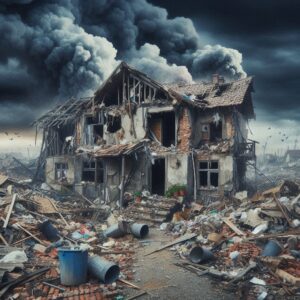 The world is on fire both literally and figuratively. Climate change is no longer a distant threat; it is happening right now. While scientific warnings have been clear for decades, global leaders have either failed to act or actively fueled the crisis. Meanwhile, war rages on as if it were an unavoidable part of human existence. Conflicts, both new and old, continue to destroy lives, force people from their homes, and deepen global inequalities.
The world is on fire both literally and figuratively. Climate change is no longer a distant threat; it is happening right now. While scientific warnings have been clear for decades, global leaders have either failed to act or actively fueled the crisis. Meanwhile, war rages on as if it were an unavoidable part of human existence. Conflicts, both new and old, continue to destroy lives, force people from their homes, and deepen global inequalities.
The worst part? Those who suffer the most from these crises are the ones who contributed the least to them. The world’s wealthiest countries, which built their economies through decades of pollution and resource exploitation, are failing to take responsibility. Instead of prioritizing climate action and peace, they continue to fund fossil fuels, invest in weapons, and ignore the suffering of millions.
Is this the world we want? A world where climate disasters wipe out entire communities? Where wars turn entire generations into refugees? Where international agreements meant to protect humanity are broken before the ink even dries?
If we continue on this path, the future will not be one of prosperity and progress but of destruction and despair.
So I ask, is this the world I want to live in? Is this the world we want to leave behind for the generations that follow?
Climate Change: The Invisible Crisis
For too long, climate change was spoken about as a distant threat something future generations would have to deal with. But that future is now.
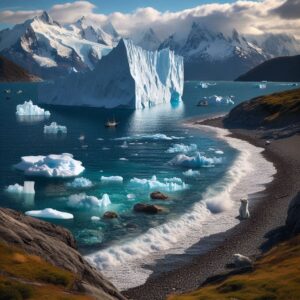 Every year, we see new records broken:
Every year, we see new records broken:
•The hottest year on record keeps shifting to the next year.
•The strongest storms are becoming even stronger.
•More people are being displaced by climate disasters than by war.
And yet, global emissions continue to rise. Why? Because of a lack of political will. Governments have had countless opportunities to act, but instead, they prioritize economic growth over planetary survival.
This failure to act is not just an oversight; it is a choice, a choice that is costing lives.
Climate change is no longer something we can ignore. It’s a global emergency affecting every corner of the Earth. From the arid deserts of Africa to the melting ice caps of the Arctic, the planet is shifting in ways that will fundamentally change our way of life. It is often said that the poor are the ones who bear the heaviest burden of the crisis, but the truth is, those who contribute the least to climate change are the ones suffering the most.
Africa contributes less than 4% of global greenhouse gas emissions, yet it is suffering some of the most devastating impacts of climate change.
Droughts in the Horn of Africa: Starvation and Mass Migration
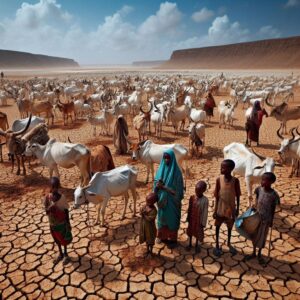 In Somalia, Kenya, and Ethiopia, persistent droughts have led to one of the worst hunger crises in modern history. The rains have failed for five consecutive seasons, killing livestock, ruining crops, and leaving millions on the brink of starvation.
In Somalia, Kenya, and Ethiopia, persistent droughts have led to one of the worst hunger crises in modern history. The rains have failed for five consecutive seasons, killing livestock, ruining crops, and leaving millions on the brink of starvation.
Families walk for miles searching for food and water. Many do not survive the journey. Children suffer from severe malnutrition, their bodies wasting away because there is nothing left to eat.
Yet, while people starve, fossil fuel companies continue to drill in Africa, extracting resources that will only make climate change worse.
The oil and gas industry in Africa is expanding, not shrinking. Instead of helping African nations transition to renewable energy, Western corporations exploit their resources, leaving destruction in their wake.
Take the case of Nigeria, where thousands of people are being displaced due to desertification and the shrinking of Lake Chad, once a major source of water for millions of people. Farmers, who relied on the lake for irrigation, are forced to abandon their crops as the water recedes, pushing them into deeper poverty. This environmental degradation is exacerbating existing conflicts in the region, as the competition for scarce resources such as water and land.
In South Sudan, the situation is dire. Climate change, coupled with ongoing conflict, has created a devastating combination. The country’s already fragile infrastructure has been destroyed by years of war, and now the unpredictable weather patterns floods and droughts further complicate the survival of its people. Whole communities, already displaced by violence, are now also displaced by climate-related disasters. Climate refugees are emerging, but unlike refugees of war, these individuals often find themselves caught in legal limbo with little to no international support. The effects of climate change in South Sudan are leading to food insecurity, violence, and health crises. And still, the world stands by, watching as the crisis deepens.
Mozambique has been hit by multiple extreme cyclones in just a few years. Cyclone Idai (2019), Cyclone Kenneth (2019), and Cyclone Eloise (2021) all brought catastrophic flooding, killing thousands and displacing hundreds of thousands more.
Each time, the country struggles to rebuild. And each time, another disaster strikes before recovery is complete. Climate change has made cyclones stronger and more frequent, turning Mozambique into a country in permanent crisis.
But Mozambique is not responsible for this crisis. Its emissions are negligible compared to industrialized nations. Why should its people suffer for pollution they did not cause?
The pattern is clear: while those who have historically emitted the most greenhouse gases the global North continue to prosper, the global South, particularly in Africa, bears the brunt of climate impacts. The wealthiest nations often make promises at global climate conferences, but their commitments to reducing emissions and financing climate adaptation fall short. Meanwhile, communities in the Global South are left to pick up the pieces, fighting for survival against rising temperatures, extreme weather, and inadequate resources to adapt.
The Failure of Political Will
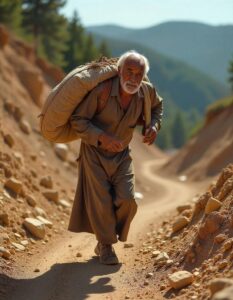 What’s more disheartening than the worsening state of the planet is the indifference of those in power. Despite all the evidence, governments around the world have been slow to act on climate change. The promises made by world leaders are often little more than political rhetoric. The wealthy, developed nations of the world have repeatedly failed to meet the financial commitments they made to assist developing nations in addressing climate change. In fact, the world’s richest countries are still spending more on defense and military interventions than on climate solutions. This stark disparity shows just how little value is placed on human life and the planet in comparison to the interests of the few.
What’s more disheartening than the worsening state of the planet is the indifference of those in power. Despite all the evidence, governments around the world have been slow to act on climate change. The promises made by world leaders are often little more than political rhetoric. The wealthy, developed nations of the world have repeatedly failed to meet the financial commitments they made to assist developing nations in addressing climate change. In fact, the world’s richest countries are still spending more on defense and military interventions than on climate solutions. This stark disparity shows just how little value is placed on human life and the planet in comparison to the interests of the few.
For example, COP26 in Glasgow in 2021 saw numerous pledges from the global North to reduce emissions and offer financial aid to the world’s poor. Yet, despite these promises, very little has changed. The commitments made at COP26 are often not legally binding, and many governments have failed to meet even their voluntary goals. As the world’s largest emitters of greenhouse gases, countries like the United States of America, China, and Russia…are the main contributors to the crisis. However, instead of taking immediate action, they continue to prioritize economic growth and energy consumption over environmental stewardship.
This lack of political will is even more devastating for those already suffering the consequences of climate change. People in low-income countries, where the effects of climate change are often most severe, are left to fend for themselves. While the global elite have access to clean energy, sustainable infrastructure, and advanced technology, the rest of the world must face the overwhelming burden of an ever-changing climate.
The Paris Agreement: A Promise the World is Breaking
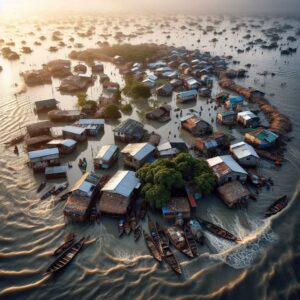 In 2015, world leaders came together to sign the Paris Agreement, promising to limit global warming to below 2°C, ideally 1.5°C. It was hailed as a turning point in the fight against climate change. But nearly a decade later, most countries are failing to meet their commitments, Global emissions are still rising. The fossil fuel industry remains one of the most profitable sectors in the world.
In 2015, world leaders came together to sign the Paris Agreement, promising to limit global warming to below 2°C, ideally 1.5°C. It was hailed as a turning point in the fight against climate change. But nearly a decade later, most countries are failing to meet their commitments, Global emissions are still rising. The fossil fuel industry remains one of the most profitable sectors in the world.
If we disregard the Paris Agreement, the consequences will be catastrophic:
•Extreme heatwaves will become the new normal, making parts of the world uninhabitable.
•Water shortages will spark conflicts over resources.
•Food production will collapse, leading to famine and economic instability.
•Biodiversity will be devastated, with mass extinctions threatening the planet’s ecosystems.
The Paris Agreement is our best chance at preventing total climate collapse, but without enforcement, it is just another empty promise.
Loss and Damage: Will the Rich Pay for the Crisis They Caused?
For years, developing nations have demanded that rich countries take financial responsibility for the climate damage they have caused.
At COP27, the world finally agreed to create a Loss and Damage Fund. This was a historic moment. But by COP28, it became clear that wealthy nations were reluctant to contribute real money.
To put things into perspective:
•Fossil fuel subsidies globally exceed $7 trillion per year.
•Loss and damage pledges so far total less than $1 billion.
This is not just unfair it is immoral. The rich polluted, and the poor are paying the price. If the Loss and Damage Fund remains underfunded, climate-vulnerable nations will never be able to recover from disasters.
War: A Never-Ending Cycle
As if the impacts of climate change weren’t enough, the world is also engulfed in a seemingly endless series of wars and conflicts. In the face of global crises climate change, pandemics, and growing inequality war continues to be a tool of politics, power, and profit. The recent conflicts in Israel-Palestine and Sudan serve as stark reminders of how war destroys lives, homes, and entire communities.
The Israel-Palestine Conflict: A War Without End
The Israel-Palestine conflict has been one of the longest and most devastating struggles in modern history. The violence between Israel and the Palestinian people has lasted for decades, with no sign of resolution. The Gaza Strip, once home to vibrant communities, has become a war zone, where airstrikes and bombings are a daily reality. Hospitals are destroyed, children are killed, and families are torn apart.
The situation is particularly dire for the Palestinian people, who have lived under occupation for generations. The ongoing blockade of Gaza has led to severe shortages of food, water, and medical supplies. Basic services such as electricity and healthcare are in constant decline, and the Palestinian people face a harsh reality of uncertainty. Israel, on the other hand, continues to face security threats and attacks, but the human cost of this conflict is immense.
Despite calls for peace from around the world, the cycle of violence continues. World leaders make statements, but real action is rare. The arms trade continues to profit from the conflict, ensuring that weapons and ammunition are always readily available to fuel the violence. War seems to have become a business, with those who profit from it showing no regard for the destruction and suffering it causes.
The War in Sudan: Conflict and Climate Crisis Collide
In Sudan, the situation is no less grim. Since the outbreak of war in April 2023, the country has been torn apart by brutal fighting between the Sudanese military and paramilitary forces. Over 3 million people have been displaced, and thousands have died. However, the conflict in Sudan is not just about power struggles climate change has played a role in exacerbating tensions.
The war over land and resources in Sudan is deeply intertwined with the environmental crisis. As desertification and the shrinking of the Nile impact agricultural production, the pressure on the land and water grows. Conflicts over scarce resources become inevitable when survival is at stake. This combination of climate impacts and political power struggles has resulted in widespread violence, with civilians bearing the brunt of the conflict.
Refugees from Sudan now flee across borders into neighboring countries like Chad and South Sudan, where the humanitarian crisis only grows. The Sudanese people, much like those in other conflict zones, are caught in a cycle of violence that seems endless. There is no refuge, no peace, and little hope for a better future.
Is This the World We Want?
We are at a crossroads. We can either:
•Take real climate action, enforce the Paris Agreement, and support the most vulnerable.
•Demand peace, stop fueling wars, and invest in diplomacy instead of destruction.
Or we can continue as we are until the planet is beyond saving.
The world we live in today is marked by inequality, injustice, and constant violence. Climate change, war, and political failure have created a perfect storm of suffering for the world’s most vulnerable. And yet, there is still hope. There is still a chance for change if we act now.
We have the knowledge, the technology, and the resources to address the climate crisis. We can reduce emissions, protect vulnerable communities, and build sustainable economies. But we need the political will to do so. We need to put people, not profits, at the center of our decision-making. We need to end the cycles of violence that devastate lives and destroy futures.
This is not the world I want to live in. Is it yours?
Edited by Cadeau NIYORUGERO

